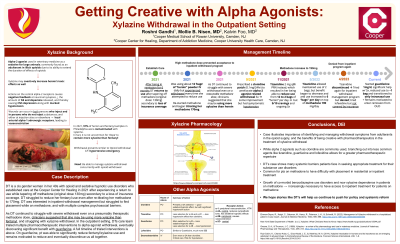Back


(58) Getting Creative with Alpha Agonists: Xylazine Withdrawal in the Outpatient Setting
Saturday, April 6, 2024
9:45 AM – 1:15 PM

Has Audio

Roshni Gandhi, MD Candidate
Medical Student
Cooper Medical School of Rowan University, New Jersey- MN
Mollie B. Nisen, MD
Physician
Cooper University Healthcare, Pennsylvania 
Kalvin Foo, MD
Physician
Cooper University Healthcare, New Jersey
Presenter(s)
Non-presenting author(s)
Background & Introduction: Xylazine is an alpha-2 agonist used in veterinary medicine as a sedative for large animals and is commonly found as an adulterant in illicit opioids due to its ability to extend the duration of effects of opioids. The prevalence of xylazine involved in deaths due to overdose has increased almost 20-fold from 2015 to 2020 in the United States and it was found that in 2021, 91% of heroin and fentanyl samples in Philadelphia were contaminated with xylazine. In fact, it is not uncommon for ‘dope’ to contain more xylazine than fentanyl. Xylazine’s actions on the central alpha-2 receptors causes negative feedback at neuronal synapses, decreasing the amount of norepinephrine and dopamine released, and thereby causing CNS depression along with marked hypotension. It’s also proposed that xylazine may coactively increase heroin’s toxic effects. While the withdrawal syndrome is not well-defined, it may mimic opioid withdrawal but is not attenuated with treatment with opioids. With the widespread presence of xylazine in illicit opioids, there is a clear need to be able to manage xylazine withdrawal concurrently with opioid withdrawal in the outpatient setting.
Case Description: DT is a cis gender woman in her 40s with opioid and sedative hypnotic use disorders who established care at the Cooper Center for Healing in 2021 after experiencing a return to use while tapering off methadone (original dose 130mg) secondary to a loss of insurance coverage.
DT struggled to reduce her fentanyl use even after re-titrating her methadone to 170mg. At that time, she was using about 12 ‘bags’ of “heroin” powder, injected daily, and experienced severe withdrawal symptoms when attempting to reduce her usage. DT was interested in inpatient withdrawal management but struggled to find placement while on methadone, and with multiple complex psychosocial barriers.
As DT continued to struggle with severe withdrawal even on a reasonable methadone dose, clinicians suggested that she may be using more xylazine than fentanyl. On September 23, 2021, she was prescribed a clonidine patch (0.1mg/24hr) to ameliorate alpha agonist related withdrawal symptoms. She felt she experienced a minimal improvement of symptoms, but developed symptomatic hypotension. In November 2021, she was prescribed tizanidine 2mg q8H PRN in lieu of clonidine, which resulted in her being able to reduce use from 12 to 2 bags of “heroin”/day. However, she reported 9/10 cravings and ongoing occasional withdrawal symptoms.
In January 2022, her methadone dose was increased to 180mg, but she felt no reduction of cravings or withdrawal symptoms. She was able to maintain her reduced use of 2-3 bags of “heroin” using tizanidine for several months. By May 2022, DT was experiencing less benefit from tizanidine, and her use increased again to approximately 6 “bags''/day on top of methadone 190 mg/day. Tizanidine was then discontinued. She and the treatment team continued to work, to no avail, to find an inpatient withdrawal management program where she could continue her methadone.
In April 2023, the provider ordered lofexidine (an alpha-2 agonist that is less centrally acting), hoping its more peripheral action would prevent the hypotension she experienced with clonidine. Unfortunately, lofexidine is not covered by insurance. Next, the team trialed guanfacine (another alpha-2 agonist) and she was started on 1mg/day. She reported significantly improved withdrawal symptoms. On guanfacine 1mg BID, she was able to maintain reduced fentanyl/xylazine use, and transitioned from injection use to mostly transnasal use. She experienced no hypotension or other adverse effects from guanfacine and remains motivated to reduce and eventually discontinue fentanyl/xylazine use.
Conclusion & Discussion: As xylazine adulteration of non-prescribed opioid supply proliferates, we share our clinical experience in hopes to help form future treatment protocols for this new chapter of the opioid epidemic. This case illustrates the importance of identifying and managing withdrawal symptoms from adulterants in the opioid supply, and the benefits of being creative with pharmacotherapeutics in the treatment of xylazine withdrawal.
While alpha 2 agonists such as clonidine are commonly used in outpatient management of OUD, branching out into less common agents like tizanidine, guanfacine and lofexidine allows for a greater pharmacotherapeutic repertoire in our efforts to ameliorate xylazine withdrawal.
DTs case also highlights some of the many systemic barriers patient’s face in seeking appropriate treatment for their substance use disorders. It is a common circumstance for patients on methadone to have difficulty with placement in residential or inpatient treatment. Given the growth of co-morbid benzodiazepine use disorders and now xylazine dependence in patients on methadone it will become increasingly necessary to have access to inpatient treatment for patients on methadone. We hope stories like DT’s will help us continue to push for policy and systemic reform.
References:
Ehrman-Dupre, R., Kaigh, C., Salzman, M., Haroz, R., Peterson, L.-K., &; Schmidt, R. (2022). Management of Xylazine withdrawal in a hospitalized patient: A case report. Journal of Addiction Medicine, 16(5), 595–598. https://doi.org/10.1097/adm.0000000000000955
New York State Department of Health. (n.d.). Xylazine: What Clinicians Need to Know. https://www.health.ny.gov/publications/12044.pdf
Greene, S. A., & Thurmon, J. C. (1988). Xylazine – a review of its pharmacology and use in veterinary medicine. Journal of Veterinary Pharmacology and Therapeutics, 11(4), 295–313. https://doi.org/10.1111/j.1365-2885.1988.tb00189.x
Ruiz-Colón, K., Chavez-Arias, C., Díaz-Alcalá, J. E., &; Martínez, M. A. (2014). Xylazine intoxication in humans and its importance as an emerging adulterant in abused drugs: A Comprehensive Review of the literature. Forensic Science International, 240, 1–8. https://doi.org/10.1016/j.forsciint.2014.03.015
Case Description: DT is a cis gender woman in her 40s with opioid and sedative hypnotic use disorders who established care at the Cooper Center for Healing in 2021 after experiencing a return to use while tapering off methadone (original dose 130mg) secondary to a loss of insurance coverage.
DT struggled to reduce her fentanyl use even after re-titrating her methadone to 170mg. At that time, she was using about 12 ‘bags’ of “heroin” powder, injected daily, and experienced severe withdrawal symptoms when attempting to reduce her usage. DT was interested in inpatient withdrawal management but struggled to find placement while on methadone, and with multiple complex psychosocial barriers.
As DT continued to struggle with severe withdrawal even on a reasonable methadone dose, clinicians suggested that she may be using more xylazine than fentanyl. On September 23, 2021, she was prescribed a clonidine patch (0.1mg/24hr) to ameliorate alpha agonist related withdrawal symptoms. She felt she experienced a minimal improvement of symptoms, but developed symptomatic hypotension. In November 2021, she was prescribed tizanidine 2mg q8H PRN in lieu of clonidine, which resulted in her being able to reduce use from 12 to 2 bags of “heroin”/day. However, she reported 9/10 cravings and ongoing occasional withdrawal symptoms.
In January 2022, her methadone dose was increased to 180mg, but she felt no reduction of cravings or withdrawal symptoms. She was able to maintain her reduced use of 2-3 bags of “heroin” using tizanidine for several months. By May 2022, DT was experiencing less benefit from tizanidine, and her use increased again to approximately 6 “bags''/day on top of methadone 190 mg/day. Tizanidine was then discontinued. She and the treatment team continued to work, to no avail, to find an inpatient withdrawal management program where she could continue her methadone.
In April 2023, the provider ordered lofexidine (an alpha-2 agonist that is less centrally acting), hoping its more peripheral action would prevent the hypotension she experienced with clonidine. Unfortunately, lofexidine is not covered by insurance. Next, the team trialed guanfacine (another alpha-2 agonist) and she was started on 1mg/day. She reported significantly improved withdrawal symptoms. On guanfacine 1mg BID, she was able to maintain reduced fentanyl/xylazine use, and transitioned from injection use to mostly transnasal use. She experienced no hypotension or other adverse effects from guanfacine and remains motivated to reduce and eventually discontinue fentanyl/xylazine use.
Conclusion & Discussion: As xylazine adulteration of non-prescribed opioid supply proliferates, we share our clinical experience in hopes to help form future treatment protocols for this new chapter of the opioid epidemic. This case illustrates the importance of identifying and managing withdrawal symptoms from adulterants in the opioid supply, and the benefits of being creative with pharmacotherapeutics in the treatment of xylazine withdrawal.
While alpha 2 agonists such as clonidine are commonly used in outpatient management of OUD, branching out into less common agents like tizanidine, guanfacine and lofexidine allows for a greater pharmacotherapeutic repertoire in our efforts to ameliorate xylazine withdrawal.
DTs case also highlights some of the many systemic barriers patient’s face in seeking appropriate treatment for their substance use disorders. It is a common circumstance for patients on methadone to have difficulty with placement in residential or inpatient treatment. Given the growth of co-morbid benzodiazepine use disorders and now xylazine dependence in patients on methadone it will become increasingly necessary to have access to inpatient treatment for patients on methadone. We hope stories like DT’s will help us continue to push for policy and systemic reform.
References:
Ehrman-Dupre, R., Kaigh, C., Salzman, M., Haroz, R., Peterson, L.-K., &; Schmidt, R. (2022). Management of Xylazine withdrawal in a hospitalized patient: A case report. Journal of Addiction Medicine, 16(5), 595–598. https://doi.org/10.1097/adm.0000000000000955
New York State Department of Health. (n.d.). Xylazine: What Clinicians Need to Know. https://www.health.ny.gov/publications/12044.pdf
Greene, S. A., & Thurmon, J. C. (1988). Xylazine – a review of its pharmacology and use in veterinary medicine. Journal of Veterinary Pharmacology and Therapeutics, 11(4), 295–313. https://doi.org/10.1111/j.1365-2885.1988.tb00189.x
Ruiz-Colón, K., Chavez-Arias, C., Díaz-Alcalá, J. E., &; Martínez, M. A. (2014). Xylazine intoxication in humans and its importance as an emerging adulterant in abused drugs: A Comprehensive Review of the literature. Forensic Science International, 240, 1–8. https://doi.org/10.1016/j.forsciint.2014.03.015
Learning Objectives:
- Recognize potential xylazine withdrawal.
- Initiate pharmacotherapeutic management of xylazine withdrawal in the outpatient setting.
- Discuss the unique treatment access needs for patients on methadone.
